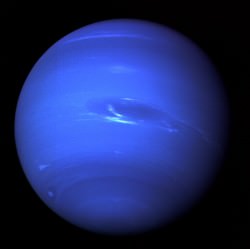The Hubble Space Telescope has identified 16 stars that could have extrasolar planets. The discoveries were made as part of a new Hubble survey, called the Sagittarius Window Eclipsing Extrasolar Planet Search (SWEEPS). This survey looked at 180,000 stars in the central bulge of the Milky Way – 26,000 light years away. The discovery was made using the transit method, where planets dim their parent stars slightly as they pass in front. Further observations will be needed to actually calculate the mass of the transiting planets.
Continue reading “Hubble Finds Distant Extrasolar Planets”
Are There Oceans on Neptune?

Continue reading “Are There Oceans on Neptune?”
A Closer Look at Planetary Formation
Astronomers have used the European Southern Observatory to map a vast disc of gas and dust surrounding a newly born massive star. The star is called HD 97048, and it’s located in the Chameleon I dark cloud, a stellar nursery 600 light-years away. The central star has 40 times the mass of our Sun, and the surrounding disc stretches 12 times further than the orbit of Neptune in our own Solar System.
Continue reading “A Closer Look at Planetary Formation”
Two Hot New Planets Discovered
An international team of astronomers have turned up two new Jupiter-sized planets orbiting distant stars. These planets are incredibly close to their parent stars; just a fraction of the distance from Mercury to the Sun. Astronomers believe these planets are being eroded by the intense radiation of their stars. The discovery was made using the new SuperWASP program, which looks for stars that dim and brighten on a regular schedule as a planet passes in front of them.
Continue reading “Two Hot New Planets Discovered”
Podcast: In Search of Other Worlds
Look down at your feet. There – you’re looking at a planet. Now look into the night sky and you should be able to spot a few more. After that, spotting additional planets becomes really hard, especially when you’re trying to find them orbiting other stars. This week we discuss the techniques astronomers use to locate distant worlds.
Continue reading “Podcast: In Search of Other Worlds”
Brown Dwarf Discovered in Planetary System
NASA’s Spitzer Space Telescope has directly imaged a small brown dwarf star orbiting a larger star – the first time this has ever been seen. The brown dwarf, HD 3651, is classified as a “T dwarf”, has about 50 times the mass of Jupiter, and orbits about 10 times the distance from the Sun to Pluto. Astronomers theorized that the system contained a brown dwarf, because a Saturn-sized planet had a strangely elliptical orbit; something was tugging on it.
Continue reading “Brown Dwarf Discovered in Planetary System”
Huge, Lightweight Planet Discovered
A new, lightweight planet has been discovered orbiting a star 450 light-years away in the constellation Lacerta. This unusual planet is larger than Jupiter, but it has only half its mass; astronomers estimate it has the same density as cork. The planet, named HAT-P-1, orbits its host star every 4.5 days. A network of automated telescopes detected how the planet dims its parent star by 1.5% when it passes in between the star and the Earth. Why this planet is so swollen is still a mystery to astronomers.
Continue reading “Huge, Lightweight Planet Discovered”
Identifying Planets with Life
Telescope technology is advancing quickly, as larger and larger instruments are getting built. Eventually, an observatory will be built capable of resolving Earth-sized worlds orbiting other stars. If there’s life there, will we recognize it? Researchers from Harvard-Smithsonian Center for Astrophysics and NASA have developed a list of epochs in Earth’s atmosphere’s history that could be visible through this instrument; from the earliest times that life emerged to our current, oxygen/nitrogen-abundant atmosphere.
Continue reading “Identifying Planets with Life”
Network of Small Telescopes Find a Big Planet
A network of amateur astronomers has discovered an extrasolar planet located 500 light years away. This incredible discovery was made using a technique that measures the brightness of thousands of stars, watching for a periodic dimming. In this case, the Jupiter-sized planet, TrES-2, orbits its host star every 2.5 days, dimming it by 1.5%. Although the planet was discovered by a 10cm telescope, followup observations were made using the 10 metre W.M. Keck Observatory on Mauna Kea in Hawaii.
Continue reading “Network of Small Telescopes Find a Big Planet”
Earth-Sized Planets are Probably Common
Of the many extrasolar planetary systems discovered so far, more than a third could contain Earth-like planets. This is according to a new study by scientists associated with NASA’s Center for Astrobiology. It was originally thought that Jupiter-sized planets should clear out their star systems as they form, but some new calculations show that they actually promote the formation of rocky planets – and even help pull in icy objects that deliver water to the inner planets.
Continue reading “Earth-Sized Planets are Probably Common”
